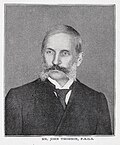File:TARTAR SOLDIERS.jpg

Original file (6,061 × 4,713 pixels, file size: 6.12 MB, MIME type: image/jpeg)
| This is a file from the Wikimedia Commons. Information from its description page there is shown below. Commons is a freely licensed media file repository. You can help. |
Summary
| DescriptionTARTAR SOLDIERS.jpg |
中文(繁體):第一次鴉片戰爭後英國在廣州設立領事館,並徵召當地人組成領事館衛隊。照片中這些英國駐廣東領事羅伯遜(Sir DB Robertson)的本地護衛隊員,或站或坐,放鬆自然,一幅輕鬆的模樣。遠處是省城(廣州)六榕寺花塔。 English: John Thomson: THE Manchus, commonly called Tartars, conquered China in 1644, but the subjugation at that date was by no means complete, and it was not until the 24th of November 1650, that Canton was taken, or rather delivered into the hands of the besiegers, by the treachery of its governor.' The Dutch ambassadors, who were in the city shortly after its capture, thus describe the scene:—
“It was upon the 25th of November, 1650, when the Tartars, upon this advantage, rushed with their whole army; which was soon subdued by them. The besieged not being in a condition to make any resistance. “The whole Tartar army being got into the city, the place was soon turned to a map of misery ; for every one began to tear, break, and carry away whatever he could lay hands on. The cry of women, children, and aged people was so great that it exceeded all noise of such loud distraction, *o that, from the 26th of November to the 15th December, there was heard no cry in the streets but, Strike, kill, and destroy the rebellious barbarians. All places were full of woful lamentations, murder, and rapine.” After the overthrow of Canton, the Tartars, following the plan which they had adopted in Peking and other cities of the Empire, established a permanant garrison composed of Tartars and of the Chinese and Mongols that had sided with them. Their encampment remains to this day, occupying about one-fourth of the entire area of the city and still retaining a few of its original characteristics, although the descendants of the warlike conquerors have lost much of their martial bearing, by adopting the luxuries, and taking up the more objectional characteristic, of the conquered race. " In establishing an encampment there were in equal portions men of the three nations who had accompanied the conqueror from Manchurian Tartary," Manchus, Mongols and Chinese. These were divided under eight banners distinguished by colours, red, blue, yellow, and so forth. In the quarters of the Tartar city occupied by the different banner-men at Peking there is a paper lantern of the banner of the occupant placed on a stand before each door-way. The banner-men of Canton number 1,800, many of them being extremely poor: for although their nominal pay is good, it never reaches the recipient in full. The government pittance is thus insufficient to support them, and while during the past two centuries they have been steadily losing their national characteristics, they have scorned to imitate the patient industry of the Chinese, or to adopt their trades and occupations. Hence the great poverty and destitution in many of the mud hovels of the Tartar quarter. Thoroughly drilled and disciplined, and with a commissariat that would provide effectively for their wants, they would still make good soldiers. Under Jui-lin, the present able governor-general of the two Kwang provinces a number of Tartar and Chinese soldiers have been instructed in the system of European drill, and in the use of foreign arms. The reader cannot fail to be struck with the fine manly build and soldierly appearance of the Tartar artillery-men shown in the photograph. These men formed the native guard of Sir D. B. Robertson, our consul at Canton. |
||||||||||||||||||||
| Date | |||||||||||||||||||||
| Source | Beinecke Rare Book & Manuscript Library | ||||||||||||||||||||
| Author |
creator QS:P170,Q736862 |
||||||||||||||||||||
Licensing
| Public domainPublic domainfalsefalse |
|
This work is in the public domain in its country of origin and other countries and areas where the copyright term is the author's life plus 70 years or fewer.
| |
| This file has been identified as being free of known restrictions under copyright law, including all related and neighboring rights. | |
https://creativecommons.org/publicdomain/mark/1.0/PDMCreative Commons Public Domain Mark 1.0falsefalse
Captions
Items portrayed in this file
depicts
1871
image/jpeg
File history
Click on a date/time to view the file as it appeared at that time.
| Date/Time | Thumbnail | Dimensions | User | Comment | |
|---|---|---|---|---|---|
| current | 10:06, 21 January 2014 |  | 6,061 × 4,713 (6.12 MB) | 維基小霸王 | User created page with UploadWizard |
File usage
The following 2 pages use this file:
Global file usage
The following other wikis use this file:
- Usage on zh.wikinews.org
Metadata
This file contains additional information, probably added from the digital camera or scanner used to create or digitize it.
If the file has been modified from its original state, some details may not fully reflect the modified file.
| Width | 11,307 px |
|---|---|
| Height | 8,557 px |
| Bits per component |
|
| Pixel composition | RGB |
| Orientation | Normal |
| Number of components | 3 |
| Horizontal resolution | 72 dpi |
| Vertical resolution | 72 dpi |
| Software used | Adobe Photoshop CS6 (Windows) |
| File change date and time | 17:17, 21 January 2014 |
| Exif version | 2.21 |
| Color space | Uncalibrated |
| Unique ID of original document | 74CB3576AC8CED498A9B1145CC718841 |
| Date and time of digitizing | 00:14, 22 January 2014 |
| Date metadata was last modified | 01:17, 22 January 2014 |
| IIM version | 37,831 |
